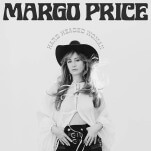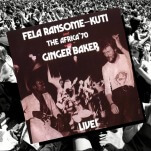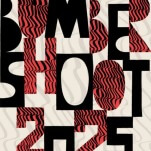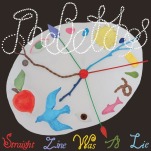These Disgusting, Fake Liquor Brands are Probably in a Gas Station Near You
Photos via Southern Eagle Distributing, Jim Vorel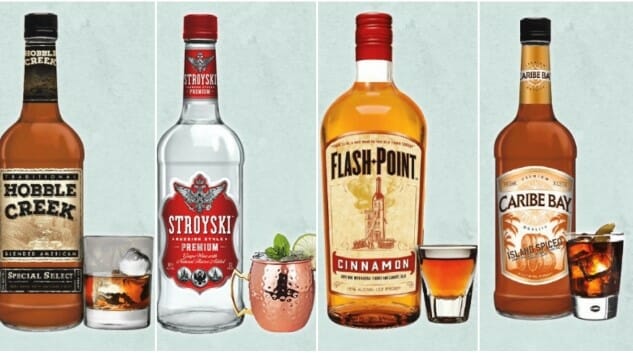
Question: When is a “distilled” spirit not really a distilled spirit?
Answer: When it’s actually a high-ABV, fermented wine, posing as a popular style of distilled liquor to trick consumers into buying it!
Look. Let me begin by saying yeah, I get it that I’m not the target demographic for the array of fake liquors I’m about to discuss in detail. You don’t need to point this out. If you’re reading this, then you most likely aren’t the target demo either. Let’s be honest: The typical Paste reader is more likely to be a collector of rare beer and scotch than they are a frequent consumer of 99-cent gas station mystery liquor bottles. But that doesn’t mean we can’t still be equal parts angry and bemused at the sheer charlatanism of what is going on here—or at the very least, disgusted to see such a brazen attempt at tricking the implied target demographic, which is the poor and the homeless. It’s not like the existence of “bum wine” is a new phenomenon, but at least the likes of Mad Dog 20/20 or Thunderbird don’t PRETEND to be something they aren’t. It’s the disguises—the putting on of airs—here that are so heinous.
So let’s get to the point: We are talking about a range—I’d say a “brand,” but they don’t have an overarching brand name—of products made by the same company that can now be found in many gas station and convenience stores, which are disguised with the aesthetic trappings of common, popular liquor styles. There’s “Stroyski,” which looks just like a Polish or Russian vodka. There’s “Old Westbury,” which looks like a dapper, London-style dry gin. There’s “Hobble Creek,” which borrows the rugged iconography of bourbon. There’s “Vera Cruz,” which puts an agave plant on its front label, but is most definitely not tequila. None are actually distilled spirits at all. Who could possibly mistake them for spirits while reading a description like this, which uses the word “vodka” three times and manages to leave the letter T out of the word “sought”?
Instead, this entire range of products are what is apparently known in industry parlance as “fermented spirits.” They’re strong, fortified wines that are produced with “natural flavors” in order to emulate whatever style of liquor they’re pretending to be. Each bottle contains the words “grape wine with natural flavor added” in the small print, for the sake of legal necessity. And they’re made (brewed?) to the maximum strength that can be sold in gas stations/convenience stores in various states. At least two different strengths exist: 16 percent ABV bottles found in the Carolinas, and 21 percent ABV bottles (which I sampled myself, I’m sad to say) found throughout Georgia. The full range of distribution is difficult to ascertain, given that information about these brands is very scarce online, but they’re also sold in Florida at the very least, and probably in numerous other states. When found at 21 percent ABV, that makes them considerably more potent than even the typical likes of Mad Dog, Night Train, Thunderbird or Cisco.
Here’s one Florida distributorship’s rather hilarious definition of the “fermented spirits” segment, which highlights its value to the consumer as the convenience of not having to make a separate trip to the liquor store in order to obtain terrible booze.
Fermented spirits are those alcoholic beverages that reach up to 42 proof (21% ABV) and are available for purchase in grocery/convenience stores in addition to bars and restaurants. These products are produced in a manner similar to spirits, but the alcohol they contain is from grape fermentation rather than distillation. For retailers, this means that fermented spirits can be sold without a full liquor license. For consumers, this means that the flavor of national brands of alcohol will be available in grocery and convenience stores without a separate trip to the liquor store.
Gee, thanks for the time-saver, guys. Why stop at the package store to pick up a bottle of Knob Creek when I can just grab some 21 percent ABV Hobble Creek whiskey-flavored wine, a product whose very name makes it sound like it will leave me with a permanent limp? That’s not an insane substitute at all. I’m sure it makes a great Manhattan. After all, they apparently use it “in bars and restaurants,” presumably of the highest caliber.
The obvious question: Who actually makes this stuff? The back of each label reads the following: “Bottled by the Brookstone Distilling Company, Lewiston, ME.”
There’s our answer, right? Well, not so fast. Do a little Googling, and you quickly see that there’s no distillery in Maine by that name, or at least none with a public face. There is a company named Boston Brands of Maine that operates a bottling plant (and apparently does some distilling) in Lewiston, Maine, though, and THEIR parent company is Sazerac Co. Which is to say: Sazerac Co., one of the two largest spirits companies in the U.S., is where the buck stops here. “Brookstone Distilling Co.” is simply a phantom name that I can only assume was designed to move the product one step further away from anyone having to take ownership of it. Oddly enough, Buffalo Trace (also owned by Sazerac) also has a subsidiary by the name of The Brookstone Distilling Co., with address listed as Frankfort, KY—where Buffalo Trace is also based. This made me wonder for a fleeting moment if the liquid in bottles of “Stroyski” and “Vera Cruz” could possibly be made by Buffalo Trace in Kentucky, so I reached out to Sazerac directly to allow them to comment on these 99-cent gas station bottles.
 The company ultimately behind these brandless bottles from the “Brookstone Distilling Co.”
The company ultimately behind these brandless bottles from the “Brookstone Distilling Co.”
The company responded quickly, pointing out that these types of beverages “are not new,” and are “made to the highest quality standards.” In fact, it turns out that their “low alcohol content” (in comparison with real, 80 proof spirits) is actually “in keeping with the promotion of moderate consumption and calorie control”—a valuable quality in any 99-cent plastic bottle of gas station hooch, I think you’ll agree. The full statement from Amy Preske, PR manager for Sazerac, reads as follows:
By way of background, these type of alternative beverages are not new, they have actually been on the market for 40+ years. Consumers are increasingly seeking out a variety of different beverages and packages in non-traditional retail outlets; spiked seltzers, craft beers, canned wines, ciders, wine and malt-based coolers have also been enjoying a resurgence.
Our products are made to the highest quality standards using proprietary wine recipes as the statement of content on the label shows and also explains the variety of outlets in which they are sold. They can be enjoyed neat plus they also make a fantastic array of mixed drinks including screwdrivers, bloody Mary, with tonic, margaritas, colada, and with Coke. Their low alcohol content is in keeping with the promotion of moderate consumption and calorie control.
These products are produced and bottled at our Lewiston, Maine facility. The Brookstone Distilling Company is one of our DBAs at our Lewiston plant. It is fairly common to have several DBA’s [which means “Doing Business As”] under one facility.
In answer to your question about if a distillery can produce these products, the answer is yes, but the correct terminology would be to say it is “produced,” in this case, produced at our plant in Lewiston, Maine.
The bottom line is that I could forgive a lot of this, if only the packaging for these products (and their marketing descriptions) didn’t try so hard to be inherently deceptive. But they do—across the board, terms like “vodka,” “gin,” “whiskey” and “tequila” are used in the description and marketing of these bottles that are none of those things. Total Wine has Stroyski in the vodka section, and describes it as vodka. So does the Sazerac brand portfolio online. In fact, the Sazerac brand portfolio website straight-up calls Old Westbury “gin,” Vera Cruz “tequila” and Caribe Bay “rum.” There’s no other word for this than lying. That’s just what it is. Sazerac’s attempted defense is to simply point at the fine print of the label and claim that its discerning clientele clearly wants to buy vodka-flavored wine, but that doesn’t mean we have to believe them. If “vodka-flavored wine” was a big selling point, it would be in bold type, not fine print.
Finally, please enjoy this Carolina distributorship that is clearly so confused by what the hell these products are that they think the line of bottles are simply called “Sazerac.” We’re sure this is exactly the kind of advertising Sazerac Co. wants associated with their name.
B&B has exciting news; we are adding Sazerac to our family! Sazerac is spirit-like wine based products at 32 proof.
Hitting the shelves early next week – look for them anywhere that sells beer! #sazeracpic.twitter.com/ZG7fNx6gLd
— B & B Distributors (@bb_distributors) April 18, 2018
A Paste Gas Station “Fermented Spirits” Tasting
And of course, because this is Paste, we had to go out and actually taste the damn things in order to know exactly how bad they really are. In a handful of Georgian gas stations I was able to find six varieties meant to replicate vodka, gin, spiced rum, tequila, bourbon and cinnamon whiskey. Online research suggests there are at least a handful more of these brands, which are meant to emulate brandy, triple sec (?), white rum and (GAG) Irish cream liqueur. Dear god, I’m glad I didn’t find THAT one.
-thumb-688x302-1075271.jpg) “Irish cream wine cocktail”? Get behind me, Satan! Oh, and by the way … they MISSPELLED THE NAME OF THE PRODUCT IN LARGE PRINT. “Delcan’s,” my god. How could this possibly get any sadder?
“Irish cream wine cocktail”? Get behind me, Satan! Oh, and by the way … they MISSPELLED THE NAME OF THE PRODUCT IN LARGE PRINT. “Delcan’s,” my god. How could this possibly get any sadder?
I present them below, in order of best to worst—because determining the worst here is obviously more fun and interesting than picking the “best.” I invite you to count the copious misspellings we unearth on this journey together, which should be a fun and educational little game for the kids at home.
1. Old Westbury London Style Extra Dry
Pretending to be: Gin
By far the most palatable of these tiny plastic bottles is the Old Westbury, “London Style Extra Dry” … something or other. They made sure to use all of the most common gin words in that title, didn’t they? Here’s the product description I could find online:
Nestled under the bluffs in England’s Wlishire [sic] County is the small market town of Old Westbury. Old Westbury Extra Dry is a drink crafted in homage to the rich character of the English. Embodies English botanicals and strong Juniper notes. Perfect in any cocktail.
So, it’s inspired by an unrelated, misspelled county (it’s “Wiltshire”) in England, is crafted in homage to the “rich character” of the English people themselves, and “embodies” (which is a nice way to say “does not necessarily contain”) English botanicals. Sounds about right. All of these fermented spirit descriptions are laid out in this very precise (but constantly misspelled) legalese, no doubt designed to protect them from claims of false advertising.
On the nose, Old Westbury actually smells pretty approachable—light pine, and sweet lemon-lime soda. It’s not too far off from actual gin, to be honest, or at least a “New Western”-style gin like New Amsterdam. On the palate, it’s quite soda-like, with heavy lime candy flavor, like a green Lifesaver. Fairly mild and neutral otherwise, it’s lightly sweet but quite watery in texture (which was universal in all of these). Booze is minimal, especially compared to the others in this tasting. Pine and light floral notes round out what was by far the best of these bottles. Compared with the rest, this one is royalty. I expect that if you told someone it was REALLY cheap gin, they might actually believe you, except for the texture being all wrong.
But buckle up, because it gets a lot worse from here on out.
 Because I assume you want proof of my gas station fake liquor harvest, here you go.
Because I assume you want proof of my gas station fake liquor harvest, here you go.
2. Stroyski Russian Style Premium
Pretending to be: Vodka
I preemptively feared that the vodka-style imitation of Stroyski might represent the worst this field had to offer, but it’s saved on some level by its relative blandness. Here’s what Sazerac’s description has to say:
No drink is more closely associated with Russia than vodka (translated from a Russian word meaning “little water”). Since it was first produced in Russia back in the mid-fifteenth century, vodka has become one of the most commonly consumed spirits in the world. Much of vodka’s popularity is due to its neutral flavor, making it the perfect addition to any cocktail. We have sough [sic] to capture this classic characteristic with Stroyski. Mix and match in your favorite drink and raise a glass with friends. Cheers!
Truth in advertising here, as aside from saying “vodka” over and over in that description, they’re pretty accurate about the “neutral flavor.” Stroyski, to my genuine relief, doesn’t taste much like anything. Lightly boozy, with a slightly buttery quality that reminded me of the smell of cooking rice, it just tastes like watery, neutral booze. A hint of nail polish on the nose, and very flat and flabby on the palate—it reminds me of grain alcohol mixed with club soda that has lost all of its carbonation. In fact, you might as well just dump Everclear into water and dilute it to 21 percent ABV, because you’d end up with functionally the same thing as this. This stuff’s only purpose is to deliver alcohol directly into the bloodstream without dealing with the complications present in “taste.”
-

-

-

-

-

-

-

-

-

-

-

-

-

-

-

-

-

-

-

-

-

-

-

-

-

-

-

-

-

-

-

-

-

-

-

-

-

-

-

-

-thumb-688x321-1075265.jpg)
-thumb-688x311-1075289.jpg)
-thumb-688x308-1075292.jpg)
-thumb-688x326-1075298.jpg)
-thumb-688x308-1075301.jpg)












